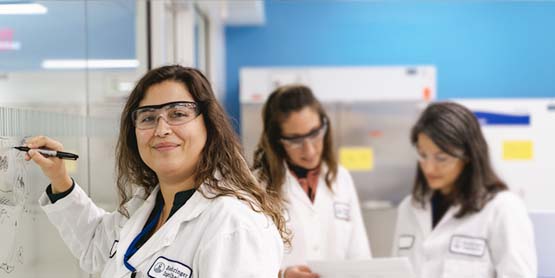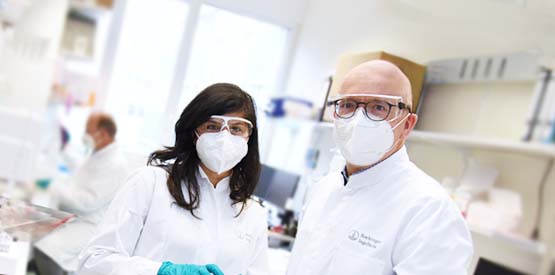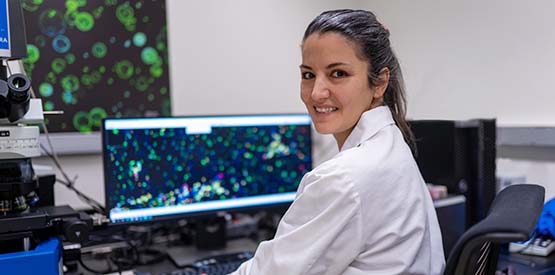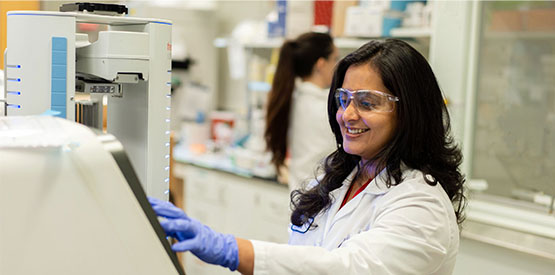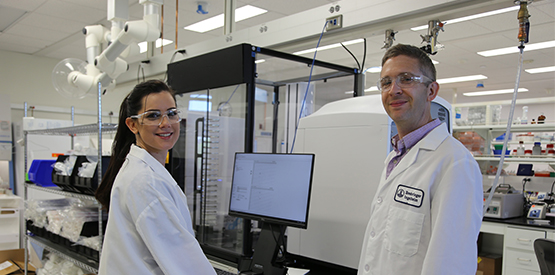Role of HSD17B13 in human disease beyond hepatocytes
Using novel human cellular systems, how would you propose to investigate the functional role of HSD17B13 outside hepatocytes with relevance to human disease?

Damian Matera
Senior Scientist
Boehringer Ingelheim
All incoming answers accompanied by a collaboration proposal will be evaluated by a scientific jury, and, upon selection, chosen proposals are pursued through a joint collaboration with the successful applicants. Initial funding of up to 200,000 euros will be available for proposals that will receive support by our review team.
Background information
What is the context of the problem that we would like to solve?
The 17b-hydroxysteroid dehydrogenase (HSD) family of oxidoreductases act on a range of lipid substrates. Whereas a key role for certain family members in steroid metabolism is well-established, the physiological function of others is less well characterized.
HSD17B13 (also known as Hydroxysteroid 17-Beta Dehydrogenase 13 or 17-beta-HSD 13) is a lipid-droplet associated member of this family, most highly expressed in hepatocytes, though expression is also observed in additional tissues/cell types. Multiple substrates for the human enzyme have been demonstrated in vitro, including estradiol, retinol and LTB4.
The potential importance of HSD17B13 as a target for therapeutic intervention stems from multiple human genetic studies that demonstrated a strong link between Loss of Function (LoF) variants in HSD17B13 and protection from non-alcoholic steatohepatitis (NASH), as well as alcoholic liver disease. Both small molecule inhibitors and hepatocyte-directed siRNAs are being pursued as potential therapeutic options for these diseases.
However, although the enzyme’s highest expression is in hepatocytes, the beneficial effect of the LoF variants to ameliorate the inflammatory processes of NASH progression requires that other cell types are involved. This could be mediated entirely through the modulation of hepatocyte HSD17B13-derived lipid signals or could include direct effects of LoF in non-hepatocyte cells (resident in the liver, infiltrating with disease progression, or located in other tissues).
Additionally, non-hepatocyte HSD17B13 may be relevant to diseases other than NASH.
This is the core of this research question on opnMe - whether non-hepatocyte HSD17B13 activity in humans may contribute to risk for NASH or other diseases. To investigate this question and validate findings as part of in vitro studies, we offer our novel, unprecedented small molecule HSD17B13 inhibitor to selected applicants.
What potential solutions could be in scope?
- Studies demonstrating a human disease-relevant role of HSD17B13 outside hepatocytes.
- In vitro approaches using human cells.
- Whereas a compelling case for human disease relevance must be made, likely using human cellular systems, it is possible that the overall data package may be bolstered by the inclusion of additional data derived from rodent cells /in vivo studies.
What potential solutions would be out of scope?
- Demonstration of a likely disease-relevant role solely in non-human species/cells without compelling evidence that the role is relevant to humans.
- Evidence for a likely relevant role of HSD17B13 in a disease other than NASH, if the mechanism is wholly based on HSD17B13 in hepatocytes.
- Studies that clarify the mechanism whereby hepatocyte HSD17B13 LoF decreases the risk of NASH.
What benefits do we offer to you in exchange for having submitted a solution?
Collaborating scientists will have the opportunity to directly collaborate with the Cardiometabolic Diseases Discovery Research team of Boehringer Ingelheim.
Appropriate funding for the prospective collaboration period is available. The exact funding request should be outlined in the submitted proposal. As a framework, we suggest that the initial funding request is structured in milestones and does not exceed 200,000 euros per submitted proposal.
Selected candidates will receive access to our exclusive HSD17B13 inhibitor suitable for in vitro use, to validate their hypothesis.
Furthermore, the opportunity for a funded stay at Boehringer Ingelheim for technology exchange / training is potentially available, as is the availability of custom biological tools and reagents.
Our collaboration agreement will provide full transparency about each partner’s rights & obligations (including intellectual property rights). As part of the agreement, you will be encouraged to publish following the collaboration agreement (to be negotiated in good faith).
To maintain the highest degree possible in an open innovation environment, we plan to announce the winner(s) publicly and feature them on opnMe.com and our social media channels.
What are the key success criteria on which we base our selection for the best answer?
We are seeking research collaboration proposals that contain:
- A well-structured proposal outlining a new and compelling scientific approach.
- Outlining of the technical feasibility, and potentially existing data or previous publications that support feasibility / experience with outlined technology, based on existing techniques and established assays.
- Your exact funding request should be outlined in your proposal based on a well-thought-through project. The project should be structured in milestones and planned with key decision points (clear Go/No-Go criteria). The funding request for the initial milestones resulting in a Go/No-Go decision should not exceed 200,000 euros per submitted project in total.
- Proven track record in the required field of expertise.
- Ability to implement the outlined solution as part of a scientific collaboration project with Boehringer Ingelheim including access to a laboratory.
What information should be included in your answer submission?
Please use our answer submission template to provide a 2-3 page non-confidential proposal (available for download here).
If confidential data exists that would strengthen the proposal, please indicate that information is available to share under a Confidential Disclosure Agreement (CDA). If we find the non-confidential concept proposal sufficiently interesting, we will execute a CDA for confidential discussions.
Summary
We are currently seeking answers for the following scientific challenge: Using novel human cellular systems, how would you propose to investigate the functional role of HSD17B13 outside hepatocytes with relevance to human disease?
All incoming answers accompanied by a collaboration proposal will be evaluated by a scientific jury, and, upon selection, chosen proposals are pursued through a joint collaboration with the successful applicants. Initial funding of up to 200,000 euros will be available for each selected proposal.
We can only accept research proposals if they arrive by the submission deadline on August 23, 2022, 11.59 pm PST.





